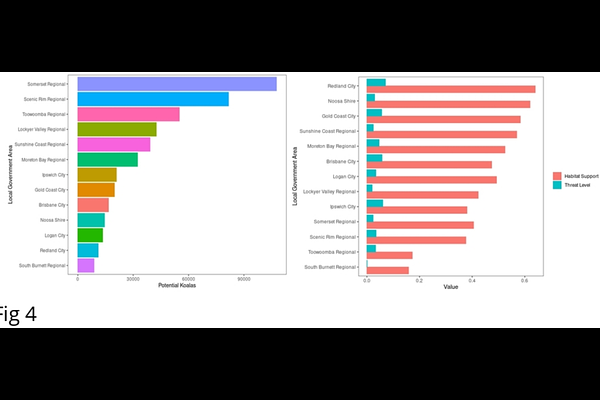A spatially targeted metric of potential koala populations based on Bayesian Networks for conservation management

A spatially targeted metric of potential koala populations based on Bayesian Networks for conservation management
Muriuki, G.; Mooney, S.; Castiglione, M.; Davis, J.; Pitchforth, J.; Johnson, S.; Duwalage, K. I.; Mengersen, K.; Wu, P. P.-Y.
AbstractKoalas (Phascolarctos cinereus) face significant threats from habitat loss and fragmentation, with South-East Queensland (SEQ) experiencing some of the most severe population declines. Current metrics used to assess conservation impacts often lack spatial resolution, transparency, or integration of diverse data sources. We propose a novel, spatially targeted metric, Koala Population Potential (KPP), to estimate the potential number of koalas that could inhabit a given area under ideal conditions. This metric is derived from a Bayesian Network model that integrates ecological, environmental, and threat data, including satellite imagery, expert knowledge, and stakeholder input. We developed and validated the KPP within an interactive online platform, the Koala Bayesian Network Platform (KBNP), enabling stakeholders to visualise and assess the conservation impact of various management scenarios at the land-parcel scale. Application of the KPP across SEQ revealed substantial spatial variation in potential koala populations. Regional areas like Somerset and the Scenic Rim exhibited high KPP scores, while urban LGAs such as Redland City and Logan had lower scores due to elevated threat levels. Model predictions of habitat support were strongly correlated with independent habitat quality assessments (R{superscript 2} = 0.803, p < .001), supporting the validity of the approach. The KBNP provides an accessible, evidence-based decision-support tool that empowers landholders, planners, and conservation managers to evaluate and communicate the likely outcomes of their actions. While developed for koalas, this framework is adaptable to other vulnerable species requiring localised, data-driven conservation planning under uncertainty.